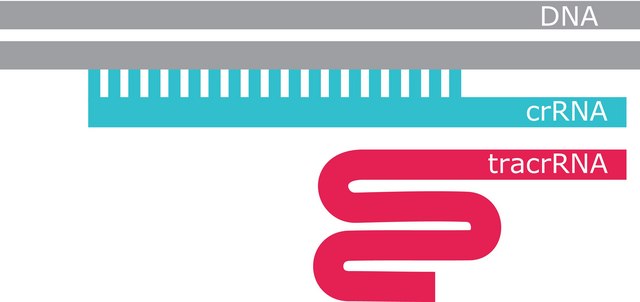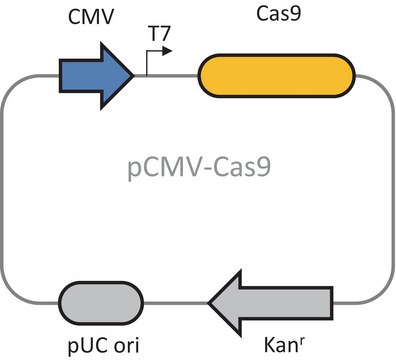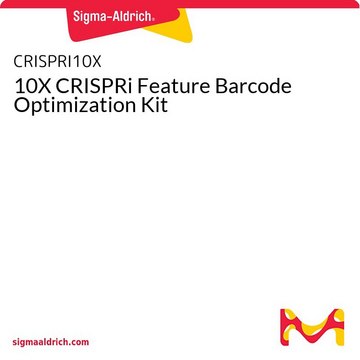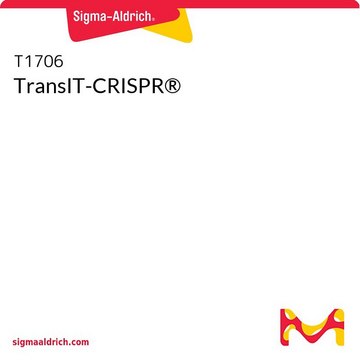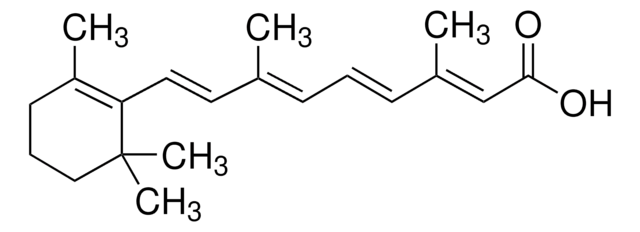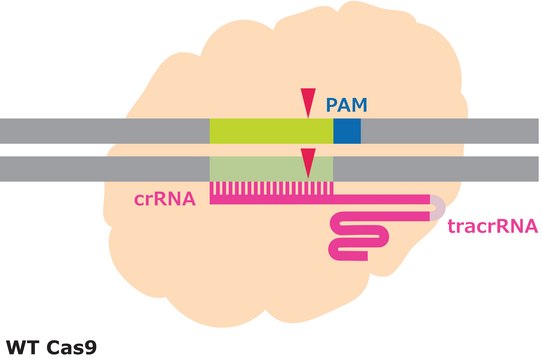推荐产品
重组
expressed in E. coli
质量水平
包装
vial of 50 μL
浓度
20 ng/μL in TE buffer; DNA (1μg of plasmid DNA)
应用
CRISPR
筛选方法
kanamycin
运输
dry ice
储存温度
−20°C
一般描述
All-in-one, ready-to-use Cas9 and guide RNA (gRNA) expression plasmids with GUS Reporter
CRISPR Plant Cas9 products are intended for Agrobacterium-mediated plant transformation. The products are based on the type IIA CRISPR-Cas9 derived from Streptococcus pyogenes. The native Cas9 coding sequence is codon optimized for expression in monocots and dicots, respectively. The monocot Cas9 constructs contain a monocot U6 promoter for sgRNA expression, and the dicot Cas9 constructs contain a dicot U6 promoter.
Arabidopsis seedlings were germinated in 6 well tissue culture plates. The seedlings were infected with Agrobacterium which had the CRISPR plasmids with a GUS reporter. After 3-4 days of transfection the GUS expression was detected. b-glucuronidase (GUS) is an enzyme that hydrolyzes colorless glucuronides to yield colored product
CRISPR Plant Cas9 products are intended for Agrobacterium-mediated plant transformation. The products are based on the type IIA CRISPR-Cas9 derived from Streptococcus pyogenes. The native Cas9 coding sequence is codon optimized for expression in monocots and dicots, respectively. The monocot Cas9 constructs contain a monocot U6 promoter for sgRNA expression, and the dicot Cas9 constructs contain a dicot U6 promoter.
Arabidopsis seedlings were germinated in 6 well tissue culture plates. The seedlings were infected with Agrobacterium which had the CRISPR plasmids with a GUS reporter. After 3-4 days of transfection the GUS expression was detected. b-glucuronidase (GUS) is an enzyme that hydrolyzes colorless glucuronides to yield colored product
应用
- To verify successful integration of T-DNA in plant genome
- GUS receptor wheat gGAPDH control for monocots for Agrobacterium mediated transformation
特点和优势
- Low cost, genome editing option compared to other methods.
- Easy to use
- Online ordering
- Ready to ship in 2 days
组分
1管含50μl的20ng/μl质粒DNA
在不使用时,将试管盖扣紧。
利用无菌实验技术,避免DNAase污染。
在不使用时,将试管盖扣紧。
利用无菌实验技术,避免DNAase污染。
原理
CRISPR/Cas systems are employed by bacteria and archaea as a defense against invading viruses and plasmids. Recently, the type II CRISPR/Cas system from the bacterium Streptococcus pyogenes has been engineered to function in eukaryotic systems using two molecular components: a single Cas9 protein and a non-coding guide RNA (gRNA). The Cas9 endonuclease can be programmed with a single gRNA, directing a DNA double-strand break (DSB) at a desired genomic location. Similar to DSBs induced by zinc finger nucleases (ZFNs), the cell then activates endogenous DNA repair processes, either non-homologous end joining (NHEJ) or homology-directed repair (HDR), to heal the targeted DSB.
其他说明
如需订购的定制的CRISPR植物产品,请访问:CUSTOM ORDERING FORM
储存分类代码
12 - Non Combustible Liquids
WGK
WGK 1
闪点(°F)
Not applicable
闪点(°C)
Not applicable
法规信息
新产品
实验方案
ZFNs and CRISPR/Cas9 advance targeted genome editing, opening new research avenues.
锌指核酸酶(ZFN)是由Sigma-Aldrich在不到8年前推出的,但是从那时起靶向基因组编辑技术已迅速发展。最近,CRISPR/Cas9 通路的发现加快了对该领域的兴趣,为研发开辟了新的可能性。
相关内容
Explore technology and reagent portfolios for plant breeding workflows, accelerating the development of new crop varieties.
我们的科学家团队拥有各种研究领域经验,包括生命科学、材料科学、化学合成、色谱、分析及许多其他领域.
联系技术服务部门
